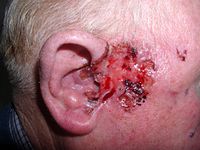
Photo from wikipedia
Dynamic contrast-enhanced magnetic resonance imaging (DCE-MRI) and ultrasound (US), which are two common modalities for clinical breast tumor diagnosis besides Mammograms, can provide different and complementary information for the same… Click to show full abstract
Dynamic contrast-enhanced magnetic resonance imaging (DCE-MRI) and ultrasound (US), which are two common modalities for clinical breast tumor diagnosis besides Mammograms, can provide different and complementary information for the same tumor regions. Although many machine learning methods have been proposed for breast tumor classification based on either single modality, it remains unclear how to further boost the classification performance by utilizing paired multi-modality information with different dimensions. In this paper, we propose MRI-US multi-modality network (MUM-Net) to classify breast tumor into different subtypes based on 3D MR and 2D US images. The key insight of MUM-Net is that we explicitly distill modality-agnostic features for tumor classification. Specifically, we first adopt a discrimination-adaption module to decompose features into modality-agnostic and modality-specific ones with min-max training strategies. Then, we propose a feature fusion module to increase the compactness of the modality-agnostic features by utilizing an affinity matrix with nearest neighbour selection. We build a paired MRI-US breast tumor classification dataset containing 502 cases with three clinical indicators to validate the proposed method. In three tasks including lymph node metastasis, histological grade and Ki-67 level, MUM-Net achieves AUC scores of 0.8581, 0.8965 and 0.8577, outperforming other counterparts which are based on single task or single modality by a wide margin. In addition, we find that the extracted modality-agnostic features can help the network focus on the tumor regions in both modalities.
Journal Title: IEEE Journal of Biomedical and Health Informatics
Year Published: 2022
Link to full text (if available)
Share on Social Media: Sign Up to like & get
recommendations!